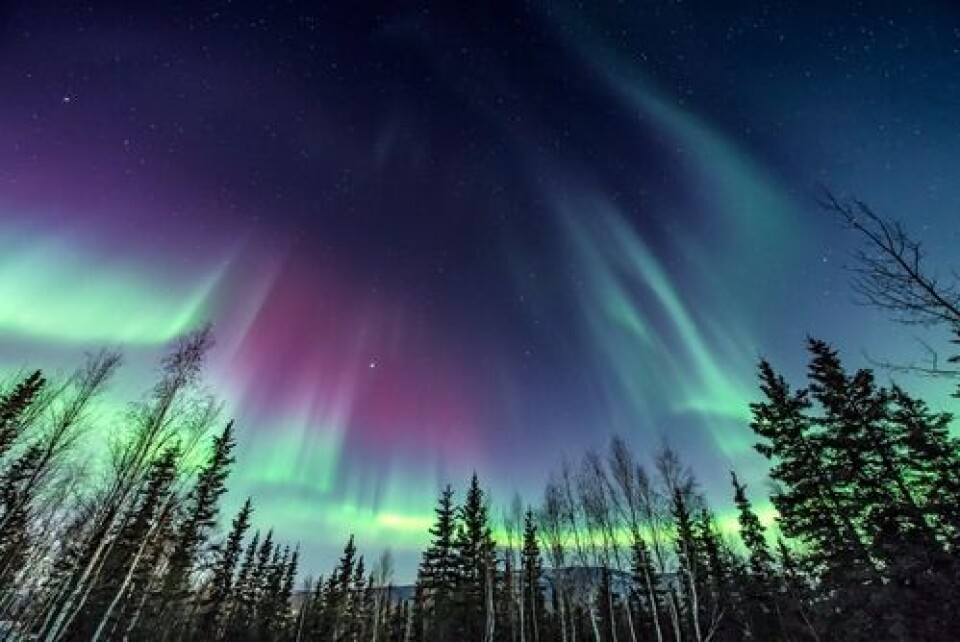-
Top Paris restaurants to sell off 20,000 tableware items
Pieces set to go on sale include glassware, cutlery, and silverware, as well as bistro tables and chairs. Money raised will go in part to charity
-
2025 world economy rankings: France classed above the UK and US
France’s low inflation rate helped it beat many other nations
-
Speed, alcohol, drugs: French ski resorts take action
Behaviour of some skiers a cause for concern as severity of injuries worsens
Northern Lights captured in spectacular photos above France
The phenomenon occurs this far south every 10 to 20 years

[UPDATE: Northern Lights were also seen overnight on Monday, February 27 to Tuesday, February 28, with more photos shared; see below.]
It is usually a phenomenon limited to countries much further north but the incredible Aurora Borealis – commonly known as the ‘Northern Lights’ – were visible in the night sky above France last weekend.
The colourful waves of light were seen on Sunday February 26, especially in the north of the country, but also in Poitou and Bourgogne, and captured by several photographers using long exposures
Agrometeorologist Dr. Serge Zaka posted a series of photos of the phenomenon on Twitter, collecting shots from observers who were able to capture the event.
Pendant que vous dormiez paisiblement, des aurores boréales ont été observées en France et immortalisées par les passionnés de météorologie sur le Photolive d'@infoclimat 👇
— Dr. Serge Zaka (Dr. Zarge) (@SergeZaka) February 27, 2023
📷FlorianBigand (Pas-de-Calais)
📷Droupi (Bourgogne)
📷 Max.B (Poitou)
📷 Sylvain62 (Pas-De-Calais) pic.twitter.com/bAx7wm0eAT
Dr. Zaka is a member of the Info Climat association, which brings together volunteers who are passionate about meteorology (the science of the atmosphere and weather).
The association website sought to describe the phenomenon and why it has appeared in northern France (and other parts of mid-northern Europe) when it usually only shows in much more northerly areas.
It said: “The Sun's activity has been very strong for several days, and a coronal mass ejection (CME) [large expulsions of plasma and magnetic field from the Sun’s corona] has reached Earth in the last few hours allowing auroras to be photographed in long exposures.”
Photographer Sylvain Wallart also shared some shots of the lights on Facebook.
He said: “They were not visible to the naked eye but in the photo you can see the red streaks easily. It lasted for a good ten minutes before the aurora faded away.”
Dr. Zaka said that the phenomenon occurs this low south every 10 to 20 years and is especially visible with a long exposure camera.
Astrophysicist Eric Lagadec, at the l'Observatoire de la Côte d'Azur, told FranceInfo that the event was exceptional.
In a Tweet, he offered some tips on how to capture the lights more brightly.
He said:
- Get away from any source of light so that your eyes get used to the dark
- Look at the north horizon
- Take photos with a long exposure on a good quality camera, and share the results!
Comment les voir? Éloignez vous de toute source de lumière, pour que vos yeux s'habituent à l'obscurité, et regardez vers l'horizon nord. Faites aussi des photos longue pose, et partagez les! pic.twitter.com/MRDZdr5obw
— Eric Lagadec✨🌍 (@EricLagadec) February 27, 2023
To see the Aurora Borealis with the naked eye so far south requires lifelong patience (literally) as it only happens around once a century on average.
[UPDATE: Northern Lights were also seen overnight on Monday, February 27 to Tuesday, February 28, with more photos shared.]
J'ai pu capturer les #auroreboreale de ce lundi 27 février près de #Fécamp, qui faisaient leur timide derrière les nuages.
Un moment magique ! pic.twitter.com/6I6BUee8he
— Etienne Farget (@EtienneFargetMC) February 28, 2023
Aurores boréales dans le Nord-Pas-de-Calais, latitude 50°N, hier soir vers 22h #auroreboreale pic.twitter.com/L4kWvlxeY0
— Louis Leroux | Astrophotographe (@KriekCherry) February 28, 2023
Related articles
#Météo #Bretagne #AuroreBoreale 🌌 Le ciel finistérien s’illumine ce soir de couleurs boréales. Fabuleux 😍
— Stéven Tual (@StevenTual_off) February 27, 2023
📸 Sébastien Choplin - Briec (29) pic.twitter.com/V9tiKwXk0v
Watch: ‘Shooting star’ meteor lights up Paris and Rouen skies
Invisibles à l’œil nu, les aurores boréales sont apparues ce lundi soir au-dessus de la #vendee grâce à une pose longue d’un appareil photo comme ici à Saint Hilaire de Riez.
— Climat Vendée (@ClimatVendee) February 28, 2023
👏 Bravo à Benjamin Mahias photographie pour les photos : https://t.co/lI62CZui4d#auroreboreale pic.twitter.com/0pqH9goL2g
Invisibles à l’œil nu, les aurores boréales sont apparues ce lundi soir au-dessus de la #vendee grâce à une pose longue d’un appareil photo comme ici à Saint Hilaire de Riez.
— Climat Vendée (@ClimatVendee) February 28, 2023
👏 Bravo à Benjamin Mahias photographie pour les photos : https://t.co/lI62CZui4d#auroreboreale pic.twitter.com/0pqH9goL2g
























